Your Power of Feeling
To think with THOT properly, you must understand that your Feelings Power your Actions.
Action solves your Problems, not Thinking about them. THOT drives the FEELINGs that animate your Actions. So the better your THOTs, the better your Actions. THOT-WARE leads you to have better THOTs!
This section takes a quick look at your THOTs and FEELINGs and how together they give you your Energy for MOTION… that’s your-
EMotion: your catalyst for Action
You and your THOTs
The previous Power of THOT section looked at THOTs & THINGs with its 5 THOT nuggets. This section has 6 THOT nuggets specifically about YOU, your FEELINGs, and your ACTIONs.
These 6 THOT nuggets are followed by a simple explanation of Emotions and a way to think about them.
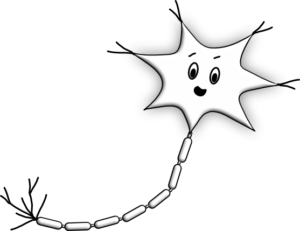 HEY!
HEY!
Nugget 1- You are your body.
The Thing that physically defines you. You were born with it and will have it for all of your life. You learned in biology about all of its parts and pieces and how miraculously they all work together.
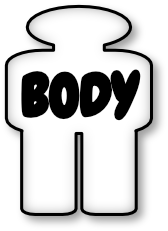
.
You’ve been living with it your whole life.
You ought to get to know it sometime.
Nugget 2- Your body feels.
Your body feels. It feels both good and bad; Pleasure and Pain, and often, some mixture of both, (even though you usually only focus on one or the other.)
You feel with your entire “nervous system” made up of
- every nerve in your body, and
- the neural network connecting them all to your
- brain, which is your Processing & Control Center.
All of your body’s feeling impulses get routed to your brain, get processed by the brain’s cells, as response signals are sent back to receiver nerves causing your body to act.
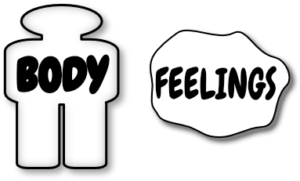
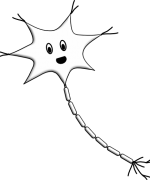
.
We brain cells like to tell the brain stem, “you’ve got an awfully lot of nerve coming in here!”
Nugget 3- Your feelings are positioned in between your body and your THOTs.
You FEEL, then those feelings get processed, then you get your THOT (about some THING.). Sometimes it’s instant, and other times it can be delayed. But, the two happen together; FEELING and THOT. They are hard-linked together by your brain and stored in your memory linked together.
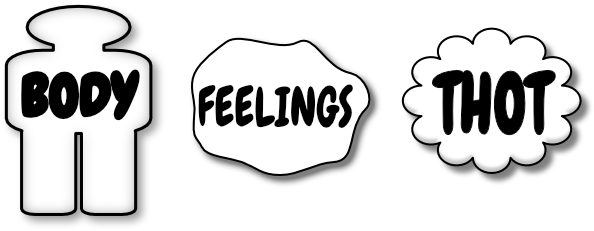
.
Yep, you can’t have one without the other. But can alter that bond.
Nugget 4- Every THOT about a THING has a FEELING attached.
THOTs about THINGs were examined in the Power of THOT section. Now we know they all come with FEELINGs.
So you have a FEELING for every THOT you have about every THING.
This “THING-THOT-FEELING” hook-up (called a triad) happens together and gets stored in your memory together. After some mental processing, this THOT-THING-FEELING triad is what forms all your Emotions about everything.
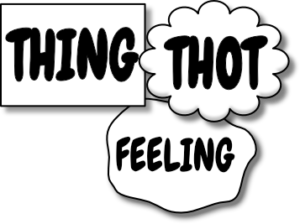
This bond is why some THOTs stir up FEELINGs, and some FEELINGs rouse up THOTs. And don’t forget, those THOTs are all about THINGs.
Remember, from up top in the intro, it’s your Emotions that make you ACT!
Nugget 5- Action is a Thing.
Not surprising, since we learned in the last section that every thing is a THING.
Action is a THING done to other THINGs. You require FEELINGs (actually Emotions) to act.
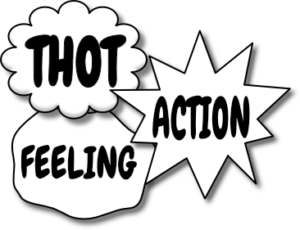
Emotion can immobilize you too, which is indeed the action of avoiding necessary action.)
.
Action is what it takes to Solve Problems.
Nugget 6- Emotions cause you to Act.
Action is a THING done by your BODY in partnership with your THOTs and FEELINGs. Your THOTs and Feelings can’t get anything done without your body doing the work.
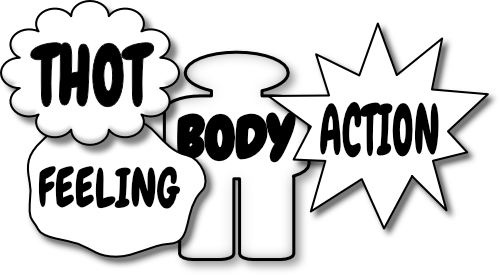
Not only does your body physically define you to the rest of the planet (as implied earlier in Nugget 1,) but the Actions you take, do too.
Your Emotions about THINGs cause you to act upon them.
.
So Emotions are FEELINGs after they have been THOT about.
EMOTIONS EXPLAINED
How Emotions Occur
Your body’s FEELINGs fall on a FEELING continuum from PAIN to PLEASURE at any given moment. Pain hurts. Pleasure feels good.
![]()
You are always feeling from different parts and places from all over your body. Even at this moment. You might not even be consciously aware of all of its goings-on.
Your THOTs (about THINGs) and FEELINGs together are emotions forming.
But, your THOTs and FEELINGs are not yet finished emotions. The THOT you have, with its FEELING, also falls on a Time continuum from PAST to FUTURE.
You have a FEELING right now, but the attached THOT is either about something that has happened (in the past) or something you anticipate might happen (in the future.)
![]()
The past can be long ago or only microseconds ago. The future may be immediate or a long way off. Either way, your mind “works out the association” between your THOTs and FEELINGs as they are stored away in your memory.
Now, with both continuums taken together, you get an Emotion.
Yes. It is really this simple.
The Feeling and Time continuums intersect at right angles, making up four quadrants.
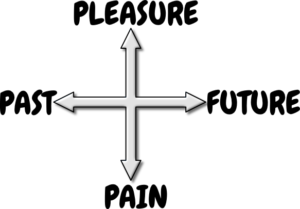
Each resulting quadrant has a “primary group emotion label” assigned to it. Depending on your THOTs-
Remembered (past) PAIN causes Sadness now.
Expected (future) PAIN causes Fear now.
Remembered (past) PLEASURE causes Happiness now.
Expected (future) PLEASURE causes Desire now.
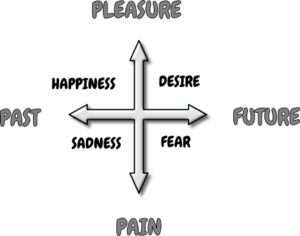
Let that soak in before reading on.
EMOTIONS TIE TO THINGS
Strong Emotions are about the THINGs most important to you. Things of little value yield very weak, sometimes unnoticed, feelings.
Your mind develops Emotions based on THINGs you Value and what you Believe to be true about them.
FURTHERMORE…
After your brain’s mental processing, you associate the Loss of Value with Pain. You associate the Gain of Value with Pleasure. So on our graph, Loss can be substituted for Pain, and Gain can be substituted for Pleasure. Remember, the Loss or Gain is about a THING you value.
And so the graph looks like this-
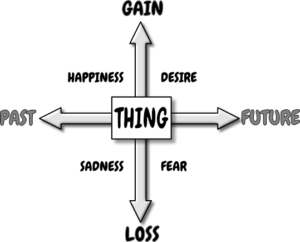
and our
PRIMARY EMOTION groups become–
- Sadness is when you have lost a Thing of value
- Fear is when you anticipate losing a Thing of value
- Happiness is when you have gained a Thing of value
- Desire is when you anticipate gaining a Thing of value.
The intensity of emotion varies with how much the THING is valued and your body’s actual FEELINGs. Many Emotional labels fall into the quadrants on this FEELING /TIME graph. You may be thinking of some right now.
But wait… there’s –
Secondary Emotions
Our four basic Primary emotions (sadness, fear, happiness, and desire) always come first in time. They can stay with you for a long time. Yet any of these primary emotions can evolve into one of the two Secondary Emotions of Anger or Love. These Secondary Emotions are derived after more mental processing. You can nurture either one of them, but you can also use them to boost your actions.
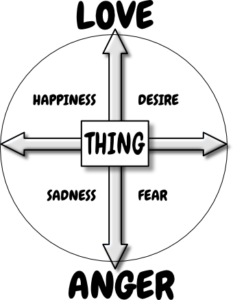
Anger falls on the Pain side of the spectrum, but it only comes as a result of first experiencing Fear or Sadness. When a Thing you value is stolen (making you sad), or you imagine it might be (causing fear), you can get mad. You get angry to give your body the physical strength you need to protect or reclaim the THING you value. When you get Angry, your body builds extra energy that you must use up in some way.
It’s always best to keep control and use that energy up constructively.
On the opposite side of the continuum from Anger is the Secondary Emotion for pleasure, which is Love. Instead of grasping onto or protecting the THING you Value, you share it, give it away, or let it go. Love is for giving. It doesn’t mean giving all your stuff away; (but if you do, think of me.) It means you give Yourself to the THING you Value. Love gives you the energy and strength you need to Act; to help others gain things they want (or more importantly, need) and to let go of misguided beliefs and other things that hold you back.
This Emotions Map is only a two-dimensional graph of how emotions work. Real-world emotions are very complex and multi-dimensional, a mix of many THOTs and FEELINGs colliding together. But using this Map can help you better identify and label your emotions. It can help you identify the THOTs of THINGs you value, and FEELINGs you are experiencing and ideally better control your Emotions. Then that will help you take the necessary and proper Actions you need to take to better solve problems.
It’s often too easy to blame your problems and painful emotions on other people or THINGs rather than finding the actual causes and fixing them. It takes effort and self-honesty to understand, much less control your FEELINGs. Then it takes courage to take the required Actions you must take to solve your problems.
But wait, there’s still more…
Why you ACT like you do:
You have a set of self-imposed laws, called Principles, that you think if you follow them, you will be the best person you can be. You developed these laws based on what you Believe and what you Value.
Your chosen Principles are known only to you and is one THING that sets you apart from everybody else. When you Act according to your ideal principles, your life is good.
But you don’t always Act according to your Principles. It’s often easier to break your own laws and take an action with less resistance (which avoids immediate pain): either from just being lazy or afraid of what you think other people might think of you.
But beware: you will find less self-loathing in the long run and more future Pleasure by Acting in accordance with your chosen Principles.
Read on for more detail-
PRINCIPLES
Your Principles are your personal laws for proper and prosperous living. You live and act according to them.
You need them to direct your Actions in every THING you encounter. Thinking and Acting according to your established personal laws makes your life run more smoothly.
You built your Principles from your life-long collection of BELIEFS and VALUES. You spent time constructing your Principles, thinking about how to Act in every new situation. You started as a child, picking up your Beliefs and Values from your family and then your peers. As you became independent and new circumstances came along that challenged your Principles, you had to think more about and refine them.
If your Principles work for you, keep them. But oftentimes, Problems are caused as a result of everyday THINGs colliding with your Principles, more precisely, the Beliefs you built them on. When a Principle no longer serves, you must be willing to change it. (With any luck, THOT-WARE can help.)
Your memory stores your Principles, Beliefs, and Values, along with all your other THOTs and FEELINGs. They allow you to behave habitually most of the time, which sure makes your life easier and saves you a lot of thinking energy. You call upon Principles daily to make everyday decisions and take action. But when they fail you, it’s best to be open to confront and alter your own self-imposed laws.
EXAMPLES (of one’s best behaviors)-
- I will be kind to animals
- I will be polite in mixed company
- I will be afraid…or at least won’t show my fear
- I will treat all people with kindness
- I will do unto others as I would want them to do unto me
- I will live like there is no tomorrow but plan like I will live forever
- I won’t fart in public
- I will take responsibility for what I say and do
- I won’t do today what I can put off for tomorrow
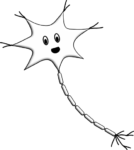
BELIEFS
Beliefs are the first component of established Principles.
Your Beliefs are the THINGs you think are true about everything in your universe, and beyond. They are your THOTs about how the world works, and they are your “logical understanding” for cause-and-effect in life: physically, mentally, and spiritually. [If you think or do this, then that will happen.]
You trust your beliefs. You know some are true, from your own experience, others because of things you’ve seen and heard with your own eyes and ears. You accept the rest of your beliefs because they came from reliable and trusted sources. You know they are right because you have not experienced otherwise. As long as they work, you don’t need to change them.
Yet along life’s journey, you discover many things you once knew to be correct that proved false. As a result, you had to alter some THING you believed as fact. Your BELIEF changed, and you now accept it.
This “change of mind” always generates FEELINGs, either positive or negative. But “knowing the truth” always works out better in the long run.
What are your Beliefs?
Some BELIEF Examples-
PHYSICAL
- If you eat too much you get fat
- If you drop a rock it will fall
- If you don’t get enough sleep, you’ll be sorry
- If you spend money you don’t have, it will cost you much more in the future
MENTAL
- It’s better to enjoy it while you can, even if it means you may suffer later.
- It’s better to delay gratification now for a better future.
SOCIAL
- I’ll scratch your back, only if you scratch mine
- TIT for TAT
SPIRITUAL
- God is omnipresent and active in our everyday lives
- God is real but passive in the events of mankind
- There is no God
- Karma- what you put into the world, is what comes back to you, usually delayed
You’ve got to figure out your own.
VALUES
Values are the other component for establishing your Principles.
Values are the worth you attach to THINGs in your life. The ranked order of the THINGs you care about define your Values. Some are worth the world to you, while for other THINGs, you could hardly care less.
Values are not just about tangible objects. They are more likely to be other people, animals, relationships, character traits, activities, feelings, beliefs, yourself, as well as your stuff. The Love you have for each THING in your life determines its Value.
Your Values also change with time as you grow in knowledge, maturity, and experience. The importance you put on various Things moves up and down your Value Scale as your THOTs change with time. Your life’s direction and focus also cause them to change.
Do you think about what you Value?
Some of Joe Blow’s VALUEs-
PEOPLE
- Family, closest to most distant
- Friends,
- Neighbors,
- Co-workers
SELF
- Image
- Health
- Honesty
- Character
POSSESSIONS
- Money
- Power
- Fame
- Stuff
TIME
- Being productive
- Having fun
- Solitude
- being with Others